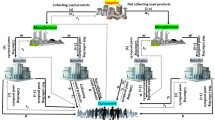Abstract
In order to find the screening mechanism of port enterprises value chain routines, based on describing the selection of port enterprises value chain routines, an evolutionary game model is presented and constructed. Using this model, we analyze the strategy of port enterprises value chain routines when they achieve the stability of the evolution. The results show that port enterprise value chain routine selection is a dynamic and repeated game. The expected revenue and convention cost of routines taking part in the game playing directly correlate with the evolutionary stable strategy and the selection of port enterprises value chain routines tend to be conservative strategy. Introducing evolutionary game theory provides a new perspective for the study on the formation, search and selection of port enterprises value chain routines and provides favorable theoretical support for further research in related fields.














Similar content being viewed by others
References
Stene, E. O. (1942). Legislative considerations in organizing regulatory agencies. Annals of the American Academy of Political and Social Science, 221(10), 49–55.
Nelson, R. R., & Winter, S. G. (1982). An evolutionary theory of economic change. Cambridge, MA: Harvard University Press.
Zollo, M., & Winter, S. G. (2002). Deliberate learning and the evolution of dynamic capabilities. Organization Science, 13, 339–351.
Liu, G. (2005). Enterprise heterogeneity hypothesis. Beijing: China Renmin University Press.
Rasenyalo, N. M. (2008). Adding value through logistics: A value chain analysis of steel product handling in Durban Port. Master’s thesis. Durban: University of kwazulu-natal.
Liu, J., & Yang, J. (2014). A study on the path of expanding supply chain value-added service in China’s port enterprises. Port Economy, 12, 9–11.
Wei, X., & Bin, H. (2014). Demand-driven simulation on the mobile value chain based on multi-stage game. Chinese Journal of Management, 22(4), 58–66.
Gao, J. (2014). Coordination coordination mechanism analysis of partners’ behavior in plant variety right value chain based on evolutionary game theory. Operations Research and Management Science, 23(5), 205–212.
Wang, Y., & Ma, J. (2011). Research on the choice of enterprise technological innovation from the perspective of organizational practice and industry practice. Nankai Business Review, 14(3), 85–90.
Winter, S. G., & Nelson, R. R. (2009). An evolutionary theory of economic change. American Journal of Agricultural Economics, 32(2), 661–666.
Feldman, M. S., & Brian, T. P. (2003). Reconceptualizing organizational routines as a source of flexibility and change. Administrative Science Quarterly, 48, 94–118.
Feldman, M. S. (2000). Organizational routines as a source of continuous change. Organization Science, 11, 611–629.
Levitt, B., & March, J. G. (1988). Organizational learning. Annual Review of Sociology, 14, 314–340.
Wang, S., & Xiaodi, H. (2009). Research on business model innovation based on value chain evolution. Market Modernization, 10, 196–197.
Hage, J., & Aiken, M. (1969). Routine technology, social structure, and organization goals. Administrative Science Quarterly, 14(3), 366–376.
Pentland, B. T., & Rueter, H. H. (1994). Organizational routines as grammars of action. Administrative Science Quarterly, 39(3), 484–510.
Cyert, R. M., & March, J. G. (2004). Behavioral theory of the firm. Systems Research & Behavioral Science, 4(2), 81–95.
Winter, S. G., & Szulanski, G. (2001). Replication as strategy. Organization Science, 12(6), 730–743.
Nonaka I. (1994). A dynamic theory of organizational knowledge creation. Organization Science, 5(1), 14–37.
Shou, Y., Wang, W., & Dmitrij, S. (2016). Design and reconstruction of value chain of manufacturing product service system—case study of Hang oxygen. Management Review, 28(2), 230–240.
Man, Q., & Jin, J. (2013). Game chain mechanism of mobile value—added service based on game theory. Journal of Industrial, 27(2), 177–186.
Hong, J., & Huang, P. (2011). Dynamic decision model of collaborative knowledge innovation in enterprise value chain. Chinese Journal of Management, 19(4), 130–136.
Huang, M. (2010). Evolutionary game analysis of cooperation mechanism for collaborative product development in supply chain. Chinese Journal of Management, 18(6), 155–162.
Pierce, W., & Smith, R. (1974). Evaluation should be a welcomed experience. Instructor, 83(8), 34.
Sun, R., & Zhao, D. (2009). Evolutionary game analysis of knowledge sharing in dynamic alliance. Operations Research and Management, 18(1), 92–96.
Huang, K. (2009). Evolutionary game and evolutionary economics. Economic Research, 2, 154–158.
Huang, M. (2010). Research on cooperation mechanism of supply chain collaborative product development based on evolutionary game. Chinese Journal of Management, 18(6), 155–162.
Chen, X., & Xu, J. (2006). Formation of network organization and its routines: Based on the views of the evolutionary theory. China Industrial Economy, 6(4), 52–58.
Taylor, P. D., & Jonker, L. B. (2010). Evolutionarily stable strategies and game dynamics. Mathematical Biosciences, 40(2), 145–156.
Acknowledgements
The authors would like to thank professors who give the valuable comments and constructive suggestions, which have greatly improved the quality of this paper. This research is supported by the National Natural Science Foundation for young scholars of China (71503029), Social Science Foundation of Liaoning (L13DJY055) and the Special Foundation for Connotative Development of Liaoning Higher Education (20110116203).
Author information
Authors and Affiliations
Corresponding author
Rights and permissions
About this article
Cite this article
Han, B., Zhang, P., Kuang, H. et al. Screening of Port Enterprise Value Chain Routines Based on Evolution Equilibrium. Wireless Pers Commun 102, 861–878 (2018). https://doi.org/10.1007/s11277-017-5110-6
Published:
Issue Date:
DOI: https://doi.org/10.1007/s11277-017-5110-6




